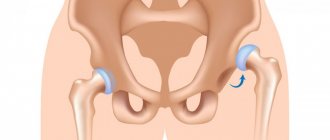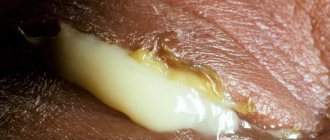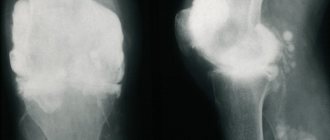A rib bruise is damage to the soft tissues of the chest as a result of a strong blow. At the same time, the integrity of the skin and bones is preserved.
As for the severity of such an injury, the purpose of the ribs is precisely to protect the internal organs from damage. However, such a bruise is always particularly painful, and can sometimes be accompanied by the development of a serious illness.
Signs of bruise
The main symptom is pain that occurs immediately at the moment of impact. A hematoma (an accumulation of blood in the tissues) may also form. The larger the hematoma, the greater the pain due to compression of soft tissues and irritation of pain receptors.
Externally, a bruise appears as swelling at the site of impact. Where subcutaneous tissue is more pronounced, swelling will be more pronounced. An example is facial tissue - here hematomas are more pronounced. When palpating the site of the bruise, the patient feels sharp pain. In case of injuries to the extremities, their functions may be impaired.
Symptoms of bruised ribs include increased pain when breathing, coughing, or laughing. The absence of a characteristic crunch when the ribs are compressed on both sides or in the anteroposterior direction does not yet indicate that there is no fracture. A severe contusion to the chest can cause other complications, such as damage to the heart or lungs. Then disturbances in the functioning of the heart or lungs come to the fore.
A form of bruise that will require the use of certain medications for treatment is a joint bruise. In this case, hemorrhage can occur not only in the periarticular tissues, but also in the joint itself. The phenomenon is called hemarthrosis, in which the joint is enlarged, its contours are smoothed, and movements in it are difficult and painful.
Elimination of the consequences of a severe bruise
Sometimes diagnostics after a rib injury can reveal a fracture, fissure, or the development of hemopneumothorax.
- As a result of a fracture, the pleura and lung can be damaged. In case of prolonged swelling, a puncture is used to remove fluid (for hemothorax) or air (for pneumothorax) from the pleural cavity. If this is hampered by clotted blood in the area of the hematoma, then surgical intervention is performed to eliminate such accumulations.
- If a crack is detected, a pressure bandage is not applied, but other standard treatment methods are used. For example, physiotherapeutic procedures (UHF, electrophoresis, Sollux, dry heat). It is important to ensure that there is no bleeding into the chest.
- Pneumonia can occur after an infection enters the lung, if the bruise leads to prolonged inflammation. In this case, antibiotics are used.
Treatment of bruises
The general principles of treatment for bruises are the same. First of all, it is the rest of the affected area of the body. On the first day, cold compresses are recommended for 2-3 hours with a half-hour break. This allows you to reduce the size of the hematoma, reduce swelling, and improve microcirculation at the site of injury.
On the second day, UHF is prescribed, and as the severity of pain decreases, compresses, ozokerite and paraffin applications are prescribed. It is possible to use agents that promote the resorption of the hematoma - ointment with heparin, as well as electrophoresis with antibiotics or novocaine (for severe pain). Novocaine can also be used to perform a blockade if taking conventional painkillers is not effective enough.
Hematomas after large soft tissue contusions are usually pierced with a thick needle, the blood is sucked out with a syringe, after which antibiotics are injected into the area and a sterile pressure bandage is applied. If blood gets into the joint, it is also aspirated. After this procedure, a plaster cast is applied. For hemarthrosis, exercise therapy is also prescribed.
Symptoms of chest contusion
The main signs of a chest contusion are:
- dull pain in the chest, which appears immediately after injury and is especially strongly felt when coughing, taking a deep breath, bending over, or other body movements;
- bruising in the injured area (there may not be a hematoma, but the risk of organ damage remains);
- swelling (increase in volume) of soft tissues.
Damage to the lungs due to a contusion of the sternum manifests itself in the following:
- superficial pain may be accompanied by deeper pain;
- blood pressure decreases, pulse increases;
- the patient experiences shortness of breath and feels short of air;
- lips turn blue, forehead is covered with perspiration;
- the patient may cough up blood.
- heart rhythm disorder
Heart damage due to sternum injury may include:
- angina pectoris - characterized by pain in the heart area;
- infarction-like - the patient experiences shortness of breath, agitation, and fever.
What not to do for bruises
On the first day after the injury, any local thermal procedures are absolutely contraindicated. Warming leads to expansion of damaged vessels, increased bleeding from them, and an increase in hematoma. When the temperature is too high, the blood in the tissues becomes a favorable environment for the proliferation of pathogenic microbes, which often leads to the development of phlegmon (spread suppuration of soft tissues).
For the same reason, you should not rub or massage a fresh bruise. Additionally, if the injury results in a fracture that is not immediately recognized, the sharp ends of the broken bone can damage soft tissue, including blood vessels and nerve endings.
How to treat bruised ribs
First, the traumatologist will take a Rib Fracture Workup / Medscape X-ray of the chest to accurately understand whether it is a fracture or a bruise. In some cases, even CT, MRI or angiography is performed. These methods help to see damage to internal organs and blood vessels.
If all is well, bruised or even broken ribs will usually heal Broken or bruised ribs / NHS on their own within 3-6 weeks. But to alleviate the condition during this period, the doctor may suggest symptomatic therapy:
- Take over-the-counter painkillers without exceeding the recommended dose.
- In the first 1-2 days, apply Bruised rib care / US National Library of Medicine an ice pack to the site of the bruise for 20 minutes 2-3 times a day to reduce swelling.
- Rest. Take a vacation if necessary.
- Breathe normally and cough if necessary. This will help clear mucus from the lungs and prevent infection. If the cough is accompanied by pain, hold a pillow to your chest.
- Move your shoulders periodically to make breathing easier.
- Do gymnastics once an hour, 10 slow deep breaths.
- The first few nights sleep on your back in a semi-upright position, and then on your healthy side.
- Drink more fluids and eat fiber-rich foods to avoid constipation. Otherwise, you will have to strain your stomach in the toilet, and your ribs will hurt more.
If pneumonia occurs, antibiotics will be prescribed to treat it. If there is internal bleeding, emergency surgery will be required.
Treatment for a stubbed toe
It is carried out according to general rules. On the first day, bed rest is desirable, then gentle walking is allowed - so as not to step on the injured finger. Treatment for a stubbed toe usually lasts no more than one week.
With severe bruises of the chest and abdomen, internal organs can also be damaged. Therefore, it is important to see a doctor as early as possible to avoid complications. You can find out more about treatment for bruises of the hand and other locations on our website Dobrobut.com. If, in the event of an injury, unknown changes develop in the tissues, immediately contact the emergency room.
What is dangerous about bruised ribs?
Due to severe pain, a person tries to breathe less deeply. Therefore, the lungs are poorly ventilated, and there is a possibility of developing Bruised rib care / US National Library of Medicine pneumonia.
At the same time as a bruise, a person can also suffer a rib fracture. It is not always possible to distinguish them from each other on your own: the symptoms are almost the same. But in case of a fracture, there is a risk of damage to internal organs, such as Blunt Chest Trauma Treatment & Management / Medscape heart, liver or spleen. If you do not see a traumatologist in time, life-threatening bleeding may occur.
Treatment
Immediately after an injury, the victim first needs to apply a cold compress to the bruised area. This will prevent bruising and reduce swelling. In order to relieve pain, you can use painkillers: Ibuprofen, Ketanov, Ketalgin, Diclofenac.
To avoid the appearance of a hematoma, cold must be applied to the injury site.
Even if the patient’s condition is satisfactory and he does not have severe symptoms that indicate damage to internal organs or fractured ribs, he must be taken to a medical facility. At the initial stage, signs of lung damage may be minor or completely absent, but will begin to increase later.
The doctor should look at the x-ray photo and finally rule out a rib fracture. A bandage is then applied to limit movement and help relieve pain. After a certain period, it must be removed, since bandaging too tightly impairs lung ventilation, which can subsequently lead to the development of post-traumatic bronchitis or pneumonia.
Treatment for bruised ribs is carried out at home. The patient should limit physical activity. It is best to sleep in a semi-sitting position, for which a large pillow is placed under the upper part of the body.
How to relieve pain
For intense pain, the patient is prescribed medications from the group of non-steroidal anti-inflammatory drugs: Nurofen, Dikloberl, Ortofen, Ketalgin, Movalis. The tablets are taken according to the instructions one to three times a day. These drugs also help reduce the inflammatory process.
To relieve pain, the use of compresses with Dimexide is effective.
A compress with Dimexide helps reduce pain and eliminate swelling from bruised ribs. To prepare it, 1 tablespoon of the drug is diluted with 4 tablespoons of boiled chilled water. A small piece of cotton fabric is soaked in the solution, secured to its side and covered with film.
Leave the compress until it dries. It can be done daily until the condition improves. Severe pain from an injury can be alleviated if, when preparing a solution for a compress, one part of the water is replaced with novocaine.
Symptoms of a bruised rib
When a rib is bruised, the following signs are noted:
- Sharp pain at the moment of injury due to a fall, impact, or pressure.
- Aching or dull pain in the area of the bruise at rest.
- Increasing pain when moving - walking, bending, turning the body, coughing, sneezing, inhaling.
- Change in breathing rhythm - it is difficult to take a deep breath, breaths are frequent and shallow.
- Swelling of the tissues in the area of the bruise, painful when touched.
- Redness of the area of injury, which over time becomes bluish.
- There may be an increase in skin temperature in the area of injury.
Important! If the victim’s condition is complicated by dizziness, severe weakness, heart rhythm disturbances, or loss of consciousness, contact a medical facility immediately.
How long does it hurt?
The duration of the disease depends on the degree and complexity of the damage, the age of the victim, the general health of the person, and the presence of concomitant lesions of the tissues and organs of the thoracic region.
With a minor injury, without internal damage, recovery occurs in 3 to 4 weeks. The pain gradually decreases, the area of injury heals after the specified period.
Ribs after a bruise can hurt for up to six months
In case of a severe bruise, if internal organs are affected, tissue or bones are damaged, the situation is complicated by the formation of a hematoma, swelling or hemorrhage, complex therapy of the injured area is required, which can last for 5–6 months.
How to distinguish a rib fracture from a bruise?
A chest X-ray will help accurately determine whether a rib is broken or bruised.
You can independently assume a fracture of the rib bones or periosteum based on the following differences:
| Symptoms | Fracture | Injury |
| Pain in the ribs | A sharp increase in pain when coughing or taking a deep breath. The rib hurts when walking, changing body position, bending, turning. | Tolerable dull pain when breathing or moving. |
| Bone deformity | Protrusion of bone fragments from under the surface tissues. With an open fracture, the skin is damaged and the bone comes out. When the body shifts, a crunching or rubbing of the bones is heard. | The surface of the fabrics is smooth, without deformation. |
| Appearance of the damage area | Hematoma, bruises, bruises on the ribs, significant swelling, painful to the touch. | Slight swelling, possible redness of the skin at the site of the injury, no bruise. |
| Breath | Deep breaths are difficult and accompanied by pain. Breathing is frequent, irregular, shortness of breath appears. | After taking painkillers, normal breathing is restored. |
| General state | Headache, weakness, cough, sleep disturbance, fatigue, nervousness, and in case of cardiac dysfunction - pain on the left side. | Slight discomfort when moving and during sleep. |
Read also: Normal heartbeat per minute
The appearance of the damaged area with a bruise and fracture is shown in the photo.
This is what a rib bruise looks like, minor spots of a darker color may appear
Extensive hematoma indicates a rib fracture
Fracture of rib and ribs
Fracture of the rib and ribs is the most common and common injury in our daily life. A person has 12 pairs of ribs and any of them can be damaged!
Fractures of the ribs occur as a result of some kind of mechanical damage - a blow, a fall on any protruding object, a road injury, a sharp compression of the chest. Depending on how many ribs are broken, the severity of the patient’s condition is determined.
What does a patient feel when a rib and ribs are fractured?
-Acute pain in the projection of the fracture, which intensifies when turning the body and taking a deep breath.
-Assumes a forced body position.
-At the moment of the act of breathing, the damaged half of the chest lags behind.
-Swelling and hematoma of soft tissues are possible in the area of the fracture site.
-When pressing on the site of injury, a crunching or crepitation may be felt as friction of bone fragments occurs.
If the patient experiences the above symptoms, it is necessary to contact a traumatologist, having first called an ambulance, or apply independently, preferably with an accompanying person.
The doctor will assess the patient’s condition, directly determine by palpation the severity and location of the fracture, prescribe an X-ray examination, and in the most serious cases, or for the most reliable examination, prescribe a computed tomography scan. Subsequently, based on examination and examination of the patient, treatment will be prescribed. As a rule, it is either conservative - which can be on an outpatient basis under the supervision of a traumatologist, or inpatient - in a hospital under the supervision of a thoracic surgeon or traumatologist.
In case of an uncomplicated fracture of a rib or ribs, the traumatologist will correctly select the method of conservative treatment.
Prescribe modern and most effective NSAIDs in the form of intramuscular or oral administration. Prescribe NSAID ointment. The patient will also be advised to eliminate physical and intense dynamic stress and create rest.
To enhance therapy, it is possible to prescribe physiotherapy (UHF, Magnetic therapy, electrophoresis, etc.) It is also recommended to use calcium supplements with Vit. D3, breathing exercises. It is also necessary to follow the doctor’s recommendations during sleep, if you have trouble sleeping in a flat lying position, or if you need to take a semi-sitting position with elastic pillows under your back using a reclining chair or bed. If you follow your doctor's recommendations, you will be able to restore motor and physical activity in the shortest possible time.
On average, the healing time for an uncomplicated rib fracture is 3-4 weeks.
Restoration of full working capacity occurs in 4-6 weeks. after injury. It is also necessary to take into account the age of the patient; younger people recover faster.
In case of complicated rib fractures accompanied by pneumothorax (when the lung is ruptured by a rib fragment and the accumulation of free air between the sheets of the pleura), hemothorax (accumulation of blood in the pleural cavity, which leads to compression of the lung), subcutaneous emphysema (entry of air from the lung into the subcutaneous tissue), organ injuries abdominal cavity (mainly lower ribs), heart injury (if damaged by the ends of the ribs) - immediate hospitalization is required.
Diagnostics
In case of chest injury, it is recommended to visit the trauma center for an X-ray examination in order to exclude more serious injuries.
During the initial examination of the patient, a medical history is taken: the doctor finds out the causes of discomfort in the chest area - after a blow, during a fall, mechanical impact, excessive physical stress on this area.
X-rays are taken to confirm or rule out damage to internal organs
To exclude damage to the internal organs located under the rib band, the patient is sent for an x-ray. Darkening areas on the film indicate injury to areas of the lungs. If more serious complications, the formation of foci of hemorrhage and other pathologies are suspected, a chest MRI is prescribed.










